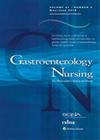何时取下鼻胃管:内窥镜检查之前还是之后?
IF 0.7
4区 医学
Q4 GASTROENTEROLOGY & HEPATOLOGY
Gastroenterology Nursing
Pub Date : 2023-09-01
Epub Date: 2023-05-09
DOI:10.1097/SGA.0000000000000732
引用次数: 0
摘要
本文章由计算机程序翻译,如有差异,请以英文原文为准。
WHEN REMOVE THE NASOGASTRIC TUBE: BEFORE OR AFTER ENDOSCOPY?
Enteral nutrition is an alternative nutrition method for patients whose digestive system is functional but cannot be fed orally (Bankhead et al., 2009). The use of nasogastric feeding tubes (NGFTs) is common and clinicians often underestimate their placement, function, and maintenance (Prabhakaran et al., 2012). Due to complications that may occur during NGFT placement, it is recommended that the procedure be performed only by trained personnel (Creel & Winkler, 2007; Eldar & Meguid, 1984; Özdemir, Öztürk, Öcal, Metiner, & Onur, 2015). Confirmation of the position of the NGFT is crucial both during insertion and subsequent use (Braegger et al., 2010). Some clinicians evaluate the localization of the tube by giving air through the feeding tube and hearing a rumbling sound over the epigastric region (auscultation method) (Metheny, 1988). However, it may be difficult to determine the correctness of the tube location by auscultation, even in experienced hands, especially in patients with neurological disorders, who are unconscious, or who have impaired swallowing functions (Braegger et al., 2010). The morbidity associated with the NGFT is common, but often unclear. Therefore, a high index of suspicion mandates clinical alertness and patient WHEN REMOVE THE NASOGASTRIC TUBE: BEFORE OR AFTER ENDOSCOPY?
求助全文
通过发布文献求助,成功后即可免费获取论文全文。
去求助
来源期刊

Gastroenterology Nursing
医学-护理
CiteScore
1.10
自引率
12.50%
发文量
88
审稿时长
>12 weeks
期刊介绍:
Gastroenterology Nursing: The Official Leader in Science and Practice delivers the information nurses need to stay ahead in this specialty. The journal keeps gastroenterology nurses and associates informed of the latest developments in research, evidence-based practice techniques, equipment, diagnostics, and therapy. The only professional, peer-reviewed nursing journal covering this area, Gastroenterology Nursing is an invaluable resource for current SGNA guidelines, new GI procedures, pharmacology, career development, and certification review. Its lively editorial style and illustrations make the journal a pleasure to read and consult.
Official Journal of the Society of Gastroenterology Nurses and Associates and Canadian Society of Gastroenterology Nurses and Associates
 求助内容:
求助内容: 应助结果提醒方式:
应助结果提醒方式:


